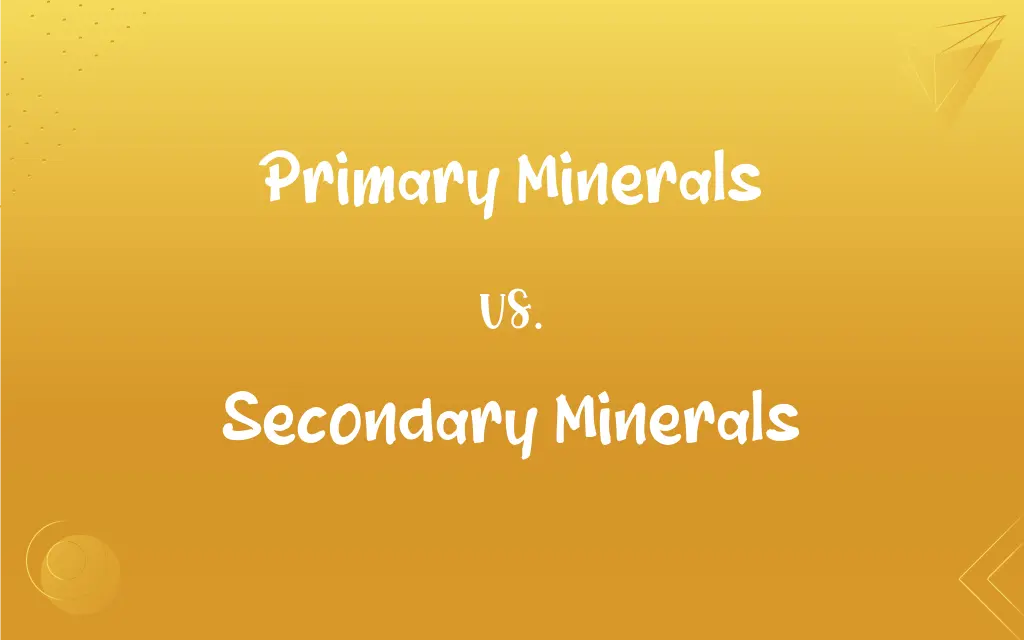Primary Minerals vs. Secondary Minerals: What's the Difference?
Edited by Aimie Carlson || By Harlon Moss || Published on January 30, 2024
Primary minerals are formed during the solidification of molten rock, while secondary minerals result from the alteration of primary minerals typically through weathering processes.

Key Differences
Primary minerals crystallize directly from molten magma, capturing the original chemical composition of the rock. Secondary minerals form from the alteration of primary minerals, usually through processes like weathering and hydrothermal activity.
In terms of stability, primary minerals are stable at high temperatures and pressures typical of their formation environment. Secondary minerals are more stable at the Earth's surface conditions and often form in lower temperature and pressure environments.
Primary minerals include minerals like feldspar and olivine, commonly found in igneous rocks. In contrast, secondary minerals such as clay minerals and oxides result from the breakdown of primary minerals.
The formation of primary minerals is linked to the cooling and solidification of lava or magma. Conversely, secondary minerals typically form in soil or sedimentary environments, where primary minerals undergo chemical changes.
Primary minerals provide insights into the geological history and original conditions of rock formation. Secondary minerals indicate the processes that have altered the rock since its original formation, like erosion or chemical weathering.
ADVERTISEMENT
Comparison Chart
Formation Process
Crystallization from molten magma
Alteration of primary minerals
Stability Conditions
Stable at high temperature and pressure
Stable at surface conditions
Common Examples
Feldspar, Quartz, Olivine
Clay minerals, Iron oxides
Geological Significance
Indicate original rock conditions
Reflect alteration processes
Typical Environment
Igneous rocks
Soil, sedimentary environments
ADVERTISEMENT
Primary Minerals and Secondary Minerals Definitions
Primary Minerals
Stable under high-temperature conditions.
Olivine, a primary mineral, forms in the high temperatures of magma.
Secondary Minerals
Form from the alteration of primary minerals.
Clay minerals are secondary minerals resulting from the weathering of feldspar.
Primary Minerals
Reflect the original composition of igneous rocks.
Feldspar, as a primary mineral, indicates the magma's composition.
Secondary Minerals
Reflect environmental changes like weathering.
The formation of kaolinite, a secondary mineral, indicates intense weathering.
Primary Minerals
Minerals formed during the crystallization of magma.
Quartz, a primary mineral, is commonly found in granite.
Secondary Minerals
Indicate surface or near-surface chemical processes.
Iron oxides, as secondary minerals, often form in oxidizing conditions.
Primary Minerals
Indicative of geological formation processes.
The presence of primary minerals like hornblende suggests a magmatic origin.
Secondary Minerals
Stable in lower temperature and pressure conditions.
Calcite, often a secondary mineral, forms in sedimentary environments.
Primary Minerals
Directly crystallized from molten rock.
Biotite is a primary mineral formed during the solidification of magma.
Secondary Minerals
Commonly found in soil and sedimentary rocks.
Gypsum, a secondary mineral, can form during the evaporation of saline waters.
FAQs
What are primary minerals?
Minerals that crystallize directly from molten rock.
What causes the formation of secondary minerals?
Typically, weathering or hydrothermal processes.
Can primary minerals be found in sedimentary rocks?
Rarely, as they primarily form in igneous rocks.
How do primary minerals form?
They form during the solidification of magma or lava.
Are secondary minerals present in igneous rocks?
No, they mainly occur in sedimentary and soil environments.
Do primary minerals change over time?
They can alter to form secondary minerals under surface conditions.
Do secondary minerals have economic value?
Yes, some, like gypsum, are valuable in various industries.
What are secondary minerals?
Minerals formed from the alteration of primary minerals.
What is an example of a primary mineral?
Quartz is a common primary mineral.
What environmental conditions favor secondary minerals?
Low temperature and pressure, typical of the Earth's surface.
How do secondary minerals help in soil formation?
They contribute to soil structure and fertility.
Give an example of a secondary mineral.
Clay minerals like kaolinite are secondary minerals.
Are primary minerals important for understanding Earth's history?
Yes, they provide insights into the original conditions of rock formation.
Can primary minerals be transformed into secondary minerals?
Yes, through processes like weathering and erosion.
What role do primary minerals play in petrology?
They are key in classifying and understanding igneous rocks.
What is the significance of secondary minerals in weathering?
They indicate the extent and type of weathering processes.
Can primary minerals be used as resources?
Yes, many primary minerals are economically important.
How do secondary minerals affect landforms?
They contribute to the development of soil and sedimentary structures.
Are primary minerals more stable than secondary minerals?
Yes, under the high-temperature and pressure conditions of their formation.
Do secondary minerals provide clues about past climates?
Yes, they can indicate past environmental and climatic conditions.
About Author
Written by
Harlon MossHarlon is a seasoned quality moderator and accomplished content writer for Difference Wiki. An alumnus of the prestigious University of California, he earned his degree in Computer Science. Leveraging his academic background, Harlon brings a meticulous and informed perspective to his work, ensuring content accuracy and excellence.
Edited by
Aimie CarlsonAimie Carlson, holding a master's degree in English literature, is a fervent English language enthusiast. She lends her writing talents to Difference Wiki, a prominent website that specializes in comparisons, offering readers insightful analyses that both captivate and inform.







































































